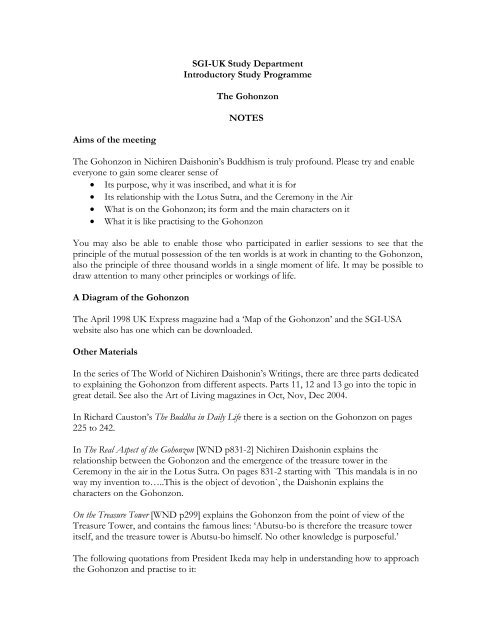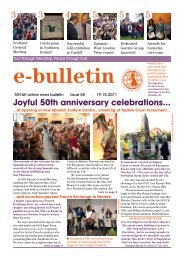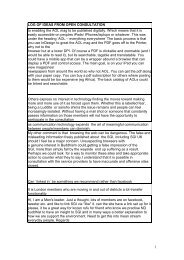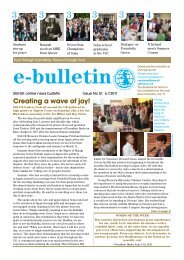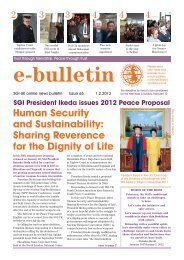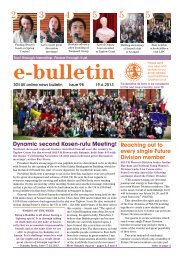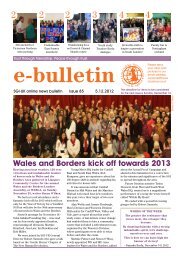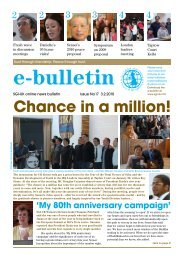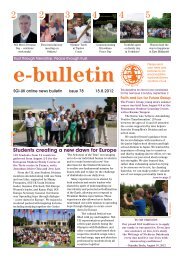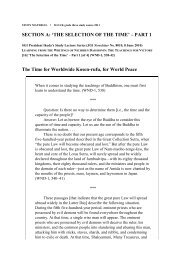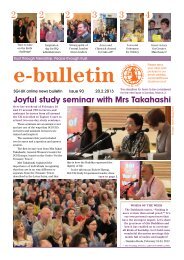SGI-UK Study Department
SGI-UK Study Department
SGI-UK Study Department
Create successful ePaper yourself
Turn your PDF publications into a flip-book with our unique Google optimized e-Paper software.
Aims of the meeting<br />
<strong>SGI</strong>-<strong>UK</strong> <strong>Study</strong> <strong>Department</strong><br />
Introductory <strong>Study</strong> Programme<br />
The Gohonzon<br />
NOTES<br />
The Gohonzon in Nichiren Daishonin’s Buddhism is truly profound. Please try and enable<br />
everyone to gain some clearer sense of<br />
Its purpose, why it was inscribed, and what it is for<br />
Its relationship with the Lotus Sutra, and the Ceremony in the Air<br />
What is on the Gohonzon; its form and the main characters on it<br />
What it is like practising to the Gohonzon<br />
You may also be able to enable those who participated in earlier sessions to see that the<br />
principle of the mutual possession of the ten worlds is at work in chanting to the Gohonzon,<br />
also the principle of three thousand worlds in a single moment of life. It may be possible to<br />
draw attention to many other principles or workings of life.<br />
A Diagram of the Gohonzon<br />
The April 1998 <strong>UK</strong> Express magazine had a ‘Map of the Gohonzon’ and the <strong>SGI</strong>-USA<br />
website also has one which can be downloaded.<br />
Other Materials<br />
In the series of The World of Nichiren Daishonin’s Writings, there are three parts dedicated<br />
to explaining the Gohonzon from different aspects. Parts 11, 12 and 13 go into the topic in<br />
great detail. See also the Art of Living magazines in Oct, Nov, Dec 2004.<br />
In Richard Causton’s The Buddha in Daily Life there is a section on the Gohonzon on pages<br />
225 to 242.<br />
In The Real Aspect of the Gohonzon [WND p831-2] Nichiren Daishonin explains the<br />
relationship between the Gohonzon and the emergence of the treasure tower in the<br />
Ceremony in the air in the Lotus Sutra. On pages 831-2 starting with `This mandala is in no<br />
way my invention to…..This is the object of devotion`, the Daishonin explains the<br />
characters on the Gohonzon.<br />
On the Treasure Tower [WND p299] explains the Gohonzon from the point of view of the<br />
Treasure Tower, and contains the famous lines: ‘Abutsu-bo is therefore the treasure tower<br />
itself, and the treasure tower is Abutsu-bo himself. No other knowledge is purposeful.’<br />
The following quotations from President Ikeda may help in understanding how to approach<br />
the Gohonzon and practise to it:
The Gohonzon is the physical manifestation of the very existence of Nichiren Daishonin<br />
who taught kosen-rufu. Because of this, if you only practice gongyo and chant daimoku and<br />
don’t take any other action for the sake of kosen-rufu or improving your own life, the<br />
Gohonzon will not have its true, full effect. If, however, you take actions to achieve kosenrufu,<br />
those actions will serve as that extra push for your own life, helping you leap to higher<br />
and higher states of mind in your gongyo and chanting. [Faith into Action p89]<br />
Josei Toda once said, ‘The Gohonzon is truly great. But because this is so simple, people fail<br />
to understand it.’ Because the Law is so profound, its practice is simple. The more<br />
technology advances, machines become simpler to operate. Mr Toda went so far as to liken<br />
the Gohonzon to a ‘happiness-manufacturing machine’. And the switch for turning this<br />
machine on is chanting daimoku for oneself and others. It could be said that Nichiren<br />
Daishonin distilled Buddhism down to irreducible simplicity for all people. [Faith into Action<br />
p114]<br />
It’s important to want to sit before the Gohonzon as though going to meet the original<br />
Buddha, Nichiren Daishonin, and that daimoku and gongyo be enjoyable. What’s most<br />
important is that you continue in your Buddhist practice throughout life. There’s no need to<br />
be overly concerned with formality. [Faith into Action p122]<br />
When looking at the Gohonzon, directing your gaze wherever is most natural for you is fine.<br />
You can look at the characters of Nam-myoho-renge-kyo in the centre, or you can gaze at<br />
the entire Gohonzon. As long as we chant with strong faith, our prayers are fully<br />
communicated. … Being human it’s natural for our minds to wander, for all sorts of<br />
thoughts and memories to surface during prayer. You can share all those thoughts with the<br />
Gohonzon. There is no set form of pattern for how we should pray. Buddhism emphasises<br />
being natural. Therefore, simply chant earnestly without pretence, just as you are. In time, as<br />
your faith develops, you’ll find it easier to focus your mind when you chant. [Faith into Action<br />
p153]


